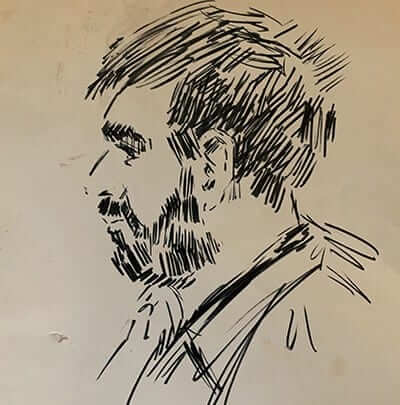“The Trial of the Chicago 7” is a trial of continence, not conscience, because the film requires emptiness in body and mind as well as a strong constitution and ignorance of the Constitution. Written and directed by Aaron Sorkin, the film betrays its source material and belittles the power of two antagonists, Abbie Hoffman and Judge Julius Hoffman, by enlarging them beyond their real-life physical proportions.
The film also bears false witness to the nature of the courtroom, replacing sterility with solemnity and artificial light with daylight. The effect is ironic from start to finish, from dressing a censor as a champion of free speech to condemning a trial—this trial—without questioning the nature of political trials in general.
The censor is Sacha Baron Cohen, who plays Abbie Hoffman but acts more like Judge Hoffman. Though Baron Cohen does not resemble the remark, he nonetheless embodies it. He expresses it whenever he attacks unpopular speech, whenever he lobbies to ban the hate he lampoons.
If he sounds like the Englishman he is, which is to say if he does not defer to first principles or the principles of the First Amendment, the reason is simple. He is a loyalist, he is a citizen from a country without a written constitution.
If he does not see the boldness of wearing a shirt of unmistakable colors, if he does not see how others could mistake a shirt for a signal, if he does not see the color of the signal, that signal red colors him Red, if he does not see that symbols are speech and flag desecration is protected speech, he is either blind or unaware of the flagpole in his own eye.
If he thinks Facebook has the same rights as publishers, that the company should not be a platform for ads promoting hate, let him lead the effort to repeal Section 230 of the Telecommunications Act of 1996. If he thinks Facebook is neither a publisher nor a public utility, let him defend the constitutionality of restricting political speech.
In the meantime, let history note that Abbie Hoffman was small but wiry, while Judge Hoffman was small and petty.
A Napoleon who praised Caesar, Hoffman was a federal judge in the empire of Chicago. He was the former law partner of the boss of the city. He was an ally of Mayor Richard J. Daley. He was not, however, the actor Frank Langella in stature or style.
Rather than showing Hoffman in a long shot, like a dim bulb beneath a grid of fluorescent lights, Sorkin softens the scene. Rather than showing how form reduces people to functionaries, Sorkin uses Hoffman the younger for comic relief. Rather than recreating the architecture of fear, of maximizing terror through minimalism, Sorkin chooses opulence.
He says what he learned from spending time with Tom Hayden, author of the “Port Huron Statement” and Hoffman’s codefendant, he could not have gotten from the trial transcript or books. Maybe if Sorkin had read Hayden’s memoir he would not have gotten so many things wrong.
Consider the import of Sorkin’s confession, that he says he knew very little about the trial before researching it, that he had a vague sense that Hoffman was a leader in the counterculture movement, that all he knew about Hayden was that he had been married to Jane Fonda for a little while.
For the record, Hayden was married to Fonda for 17 years, Hoffman has 46 credits on IMDb, and Sorkin is a discredit to art, language, laws, literature, institutions, and tradition.
His films are a trial.

